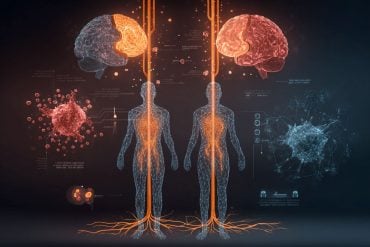Summary: A new study using DMT as a scientific tool reveals how psychedelics alter the brain’s alpha-wave dynamics and weaken our sense of self. The researchers found that DMT pushes the brain away from its usual “critical” balance between chaos and order, a state believed to be essential for coherent self-awareness over time.
This shift appears as a pronounced dampening of alpha waves, corresponding to stronger subjective experiences of ego dissolution. The findings suggest psychedelics may be uniquely suited to probing the neural foundations of consciousness and selfhood.
Key Facts
- Alpha-Wave Disruption: DMT significantly suppresses alpha activity, correlating with reports of ego dissolution.
- Criticality Shift: The drug moves the brain away from its normal balance between chaos and order, weakening the continuity of self-related thought.
- Tool for Consciousness Research: The study supports using psychedelics to examine how the brain constructs self-awareness.
Source: SfN
When people use a psychedelic called dimethyltryptamine (DMT), they experience a temporary loss of their sense of self. DMT interacts with a frequency of brain activity associated with self-referential processes (alpha waves), but it’s unclear how this activity relates to self-awareness.
Christopher Timmerman, at University College London, and Marco Aqil, currently at the University of Miami, are among researchers who used DMT as a tool to explore the relationship between alpha waves and self-awareness.
As reported in their Journal of Neuroscience paper, the researchers discovered that DMT interacts with alpha waves in a way that is associated with stronger ratings of loss of the sense of self, sometimes termed ego death. These activity changes were related to what is termed “criticality.”
Elaborates Timmerman, “The way the brain operates between chaos and order allows for normal brain function. Criticality refers to a brain state balanced between chaos and order that helps us predict things about the environment, the way we change or adapt to it, and our self-awareness.”
Furthermore, the researchers found that this shift away from criticality was a dampening or quieting of alpha waves.
Describing what this might mean, says Aqil, “We rely on past narratives and future predictions to have a coherent sense of self. In a DMT experience, people do not have a stream of consciousness over a period of time—everything takes place in the present moment.
“This shift in criticality signatures in the alpha frequency [during a DMT experience likely reveals how] the time-extended component of the sense of self is weakened.”
Both Timmerman and Aqil emphasize their work supports the idea that psychedelics may be a powerful tool for unraveling the neurological basis of human consciousness.
COI Statement
One author is a shareholder of Aspect Neuroprofiles BV, which develops physiology-informed prognostic measures for neurodevelopmental disorders. All other authors declare no competing financial interests.
Key Questions Answered:
A: DMT suppresses alpha waves and shifts the brain away from its normal critical balance, correlating with stronger experiences of ego dissolution.
A: Criticality is a neural state between order and chaos that supports prediction, adaptation, and the continuity of self-related thought.
A: Because it rapidly alters self-referential processing, allowing researchers to observe how disrupting alpha-wave dynamics affects self-awareness.
Editorial Notes:
- This article was edited by a Neuroscience News editor.
- Journal paper reviewed in full.
- Additional context added by our staff.
About this psychopharmacology and consciousness research news
Author: SfN Media
Source: SfN
Contact: SfN Media – SfN
Image: The image is credited to Neuroscience News
Original Research: Closed access.
“DMT-Induced Shifts in Criticality Correlate with Self-Dissolution” by Christopher Timmerman et al. Journal of Neuroscience
Abstract
DMT-Induced Shifts in Criticality Correlate with Self-Dissolution
Psychedelics profoundly alter subjective experience and brain dynamics. Brain oscillations express signatures of near-critical dynamics, relevant for healthy function. Alterations in the proximity to criticality have been suggested to underlie the experiential and neurological effects of psychedelics.
Here, we investigate the effects of a psychedelic substance (DMT) on the criticality of brain oscillations, and in relation to subjective experience, in humans of either sex.
We find that DMT shifts the dynamics of brain oscillations away from criticality in alpha and adjacent frequency bands. In this context, entropy is increased while complexity is reduced.
We find that the criticality shifts observed in alpha and theta bands correlate with the intensity ratings of self-dissolution, a hallmark of psychedelic experience.
Finally, using a recently developed metric, the functional excitatory-inhibitory ratio, we find that the DMT-induced criticality shift in brain oscillations is towards subcritical regimes.
These findings have major implications for the understanding of psychedelic mechanisms of action in the human brain and for the neurological basis of altered states of consciousness.







